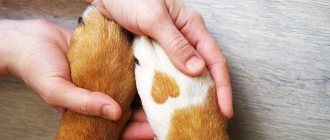What should a good kennel look like?
To make your pet feel comfortable inside your house, you just need to follow a number of simple rules. If you follow them, the likelihood of encountering such a problem as teaching a dog to sleep in a kennel will be much less.
Size and design
When choosing a dog house, you must take into account the size of the animal. The dwelling must be of such dimensions that the four-legged animal can calmly sit inside, turn around and stretch out its paws. Otherwise, he will not feel comfortable and will prefer to stay outside. Position the entrance correctly so that the wind does not blow in and cool down the home.
Material and finishing
The plastic booth is lightweight, so it can be easily moved to a new location. It is also very easy to clean. But this material has a significant disadvantage - it does not hold temperature. That is, on a hot day it gets very hot, and on a cold night it cools down.
A wooden kennel is more environmentally friendly. The tree “breathes”, which will allow you not to overheat in hot weather, and keep you warm in cold weather. But wood tends to rot. Therefore, depending on the region, such a house will last for 3-5 years.
And finally, a metal kennel is a very heavy structure, and besides, making such a house yourself is almost impossible: a saw, nails and a hammer are clearly not enough. And, again, a home made of pure metal is not able to maintain a comfortable temperature.
Location
It is better to choose a location for installation on a hill. Animals instinctively occupy a higher point in the territory for a better view. If there is no such place on the site, then the kennel can be raised a little.
It is better to make the exit from the dog house facing the entrance gate. This will make it more comfortable for the security guard to monitor what is happening.
“Interior” – what’s inside?
Depending on the climatic conditions, additional insulation/ventilation is installed inside to improve the maintenance of a comfortable temperature. For example, in the Urals and Siberia, winter temperatures can drop to minus forty degrees, and even the most shaggy dog will freeze. In the south, on the contrary, summers are hot, and in a stuffy house a pet can easily get heatstroke.
It is also very important to choose the right material for bedding. It is better not to use blankets, towels, or carpets, as they accumulate moisture and can begin to rot. In addition, such material is a breeding ground for fleas and ticks. The best thing is to lay straw mixed with cedar sawdust. Of course, the straw will also begin to rot, but during this process it releases heat and a pleasant, non-repulsive odor. And cedar sawdust, or rather, the oil contained in them, will repel insects.
How to crate train a puppy
At such an early age, training requires a more responsible approach. First, play with the puppy near his future house. Let him know that the new structure is not hostile. Next, place bowls of food and water near the entrance so that the puppy begins to slowly get used to the new home. You can also put a treat inside - the baby will be interested, and he will develop a positive attitude towards his future home.
Position the guard house next to your home so that the exit faces your front door or windows. This will make it possible to check the condition of the four-legged animal more often; it is small and getting used to it. This will prevent him from feeling abandoned, since the dog will see that every time you leave the house you go to him.
There is another trick: put your baby in a plastic bottle wrapped in a towel and filled with hot water at night. The puppy will feel more comfortable snuggled up against a source of heat.
Never lock your puppy inside. This can develop a phobia that can then be difficult to treat. Do everything gradually, carefully watching your pet.
How to train an adult dog to live in a kennel
Training an adult four-legged dog is a very labor-intensive process. Each animal has individual characteristics - both psychological and physical. Proper and consistent kennel rehoming requires taking them all into account.
From the street
In order for a dog from the street to start living in a kennel, it is necessary to show it that this is a place where it can feel absolutely safe. Place bowls of food and water near the future home, constantly moving them closer to the entrance. Sometimes put a treat inside so that the dog perceives the new structure in a positive way.
You should not force the dog inside, as this will cause fear and a lot of negative emotions. Weaning from the street will take approximately two to four weeks, but everything is very individual. Remember that the animal understands affection perfectly, even if it spent most of its life as a stray dog.
After the apartment
As a rule, it is more difficult for four-legged animals moved from apartments to adapt to their new environment. The main factor is the absence of the owner in the immediate vicinity.
To make it easier for your friend to accept and love his new home, you need to act gradually and very carefully. To get started, start playing with your pet near your new place of residence, sometimes throwing his favorite toy inside. Encourage him every time he comes inside, as well as when he himself shows interest.
Place something with the owner's scent inside. The dog should not feel that he has been abandoned, otherwise he will develop a phobia. Also, after the first overnight stays, pay extra attention to your pet. This is again necessary so that the dog does not develop a feeling of loneliness.
There is another trick - place a mechanical clock behind the kennel. Together with something with the owner’s scent, this should create a feeling of security and a familiar environment for the pet.
Use treats as rewards
Remember an important rule: do not force your dog into a new home. Your main task is to evoke exclusively positive associations with the enclosure in your pet.
Play there with the dog and feed it. Every time the dog behaves calmly and willingly enters the enclosure, joyfully praise him with words, stroking and reward him with a treat. It is better if it is food that the animal loves very much, but rarely receives - for outstanding achievements.
Guide the dog with your hand, holding a treat, towards the entrance to the enclosure and at this moment say any command you choose for this action. These could be the words “home”, “aviary”. The main thing is to define a precise and meaningful word that you will use only in this situation.
How to recover from illness: Dr. Myasnikov gave advice to COVID survivors
The cat loves his new scratching post-bed: we make it in a very simple way
Kimchi and 3 other products that normalize digestion, no worse than yogurt
You can throw pieces of treats on the ground while in the enclosure and let the dog eat them. This will also make the animal feel positive about the unfamiliar space.
Difficulties to be faced
Be patient. A new environment for an animal is always stressful.
At first, the dog may whine loudly and ask to come into the house. In such cases, never ignore your pet - go out and talk to him affectionately. Do not shout or show aggression, because the dog will not understand why he is being scolded - after all, he just wants to get to his beloved owner.
The dog may stop eating. In this case, stop putting pressure on your pet and let him get used to it on his own. Even if it takes a long time, training is not always easy.
An obstinate dog can deliberately ignore the booth, demonstrating character. In this case, you will have to show perseverance. This problem usually occurs with young male dogs. If you cannot manage your training on your own, contact a professional dog trainer for help.
Why doesn't the dog sleep in the kennel?
There are many factors why a dog won't come into the kennel. Often, a detail that is insignificant in human opinion can become a decisive argument against it for a dog.
Inappropriate house size
If it's too cramped inside, there's nowhere to turn around before lying down, it's impossible to stretch out its paws, or there's no way to sit freely, your pet will feel constrained. But if you build a house that is too large, the animal will not be able to warm it up with its body temperature on cold nights.
Inconvenient location
When choosing a site for construction, always take into account the fact that dogs instinctively try to take a higher position relative to the territory entrusted to them for a better view. This is especially true for guard breeds. And if you do not comply with this feature, no matter how hard you try, the animal will not want to live in the lowlands.
Too cold or hot
The choice of material when buying a finished house or during construction is very important. Plastic can get very hot during the day and not retain heat at night. The same applies to “bare” metal, which, in the scorching sun, can create a real steam room inside. Remember your feeling when you get into a car left in the thirty-degree sun, and everything will become clear.
For regions with a cold climate, you can heat the kennel - or take your pet into the house for the night.
Psychological moments
If someone lived in the kennel and there is still a foreign smell there, the dog can easily refuse such housing. Even an ordinary unpleasant smell will scare off the four-legged one, and he will begin to avoid his house.
The pet may have phobias associated with the newness of the home or the loss of its owner. He may decide that he is being relocated for some offense if you put too much pressure and show intemperance and aggression.
Perhaps, while in the house, the dog was frightened of something or injured itself, and this became closely connected in its head. Finally, animals also experience claustrophobia.
In difficult cases, if the dog whines and does not want to live in a booth, contact a zoopsychologist. Perhaps there is a hidden problem that is not so easy to find and resolve.
Diseases
During illness, you should not try to accustom the dog to a new home, or indeed to anything new. During such a period, he is weakened not only physically, but also psychologically. It is better to temporarily move the animal into a cottage and not put it outside until it has fully recovered.
Why does the dog refuse to go into the kennel?
Some pets flatly refuse to live in a kennel, even if it is built in compliance with all requirements. There can be many reasons, and the first of them is that the animal previously lived in a house or apartment and simply does not know what a kennel is.
The second reason is that the dog does not like the location of the kennel. Many pets like to control everything that happens on their territory, so the dog house in the yard should be placed so that the animal from it gets maximum visibility of the area.
The third reason is the lack of bedding. Not all dogs are comfortable lying on bare boards. In the warm season, you can put a rug, blanket or blanket in the booth. And in winter the kennel is stuffed with straw. It is soft and holds heat well. The shepherd will make a hole in it and will feel very comfortable.
If the dog refuses to enter the kennel, check whether the kennel meets the following requirements:
- Dimensions. The kennel should not be too spacious, as the dog will feel uncomfortable and cold in such a house. If the size of the booth is smaller than recommended, then a large shepherd simply will not fit inside. The animal should stand quietly inside, lie down and turn around. Ideal booth dimensions for VEO and German (w*d*h): 1.3m*1m*0.7m. The Caucasian Shepherd will need a more spacious home: 1.5m*1.2m*1m.
- Materials and insulation. In winter, in some regions the air temperature drops to -40 degrees, so the dog’s home must retain heat well. If a dog is cold in a kennel, it will simply refuse to live in it. The optimal sandwich of walls is a board on the outside and inside, with expanded polystyrene or polystyrene between them, 30-50mm thick.
- Entrance location. A dog may refuse to sleep in a kennel if the entrance to it is located incorrectly (on the short side), which is why strong winds constantly blow into the house. The hole should be located in a long wall, as close to the edge as possible; the presence of a vestibule in front of it is only a plus.
- No odors inside. Dogs have a very sensitive sense of smell and may refuse to enter a kennel that has a strong odor. Therefore, check whether there are any sharp “aromas” of paint or impregnations left inside the house.
Training Tips
To summarize, it is worth highlighting the key points on how to train a dog to a kennel in the yard. All the tips are simple, but at the same time effective.
What will help
Useful recommendations, the observance of which will not only speed up the process, but also make it smoother:
- observe the proportions of the room based on the size of the pet;
- take into account the location when constructing, choosing a hill;
- the kennel must be made correctly and from suitable materials, without burrs, splinters and protruding nails;
- monitor the cleanliness of the booth and its sanitary condition, change the bedding on time and treat it from parasites;
- use tricks, such as a watch, something with the owner’s scent, bottles of hot water, and add a treat at first.
Pay attention to the behavior, general physical and psychological state of your four-legged friend. The training of a future security guard may not always go smoothly. Be careful and patient.
Place your dog's favorite toy in the kennel
If your animal has favorite toys, then put them in the booth for the first time of habituation. This way they won’t be sad to be left alone in the new house.
If your pet doesn’t have any favorite toys or he’s already elderly and for this reason doesn’t play much, then you can put the owner’s thing in the booth. This will let the animal know that the owner is always with him.
The tips given are easy to follow and will allow you to train your dog to the kennel in a short time. The main condition for success is gradual adaptation to a new “home”.
This will avoid severe stress on the animal. And also to establish his own “life” outside the usual city sofa.










